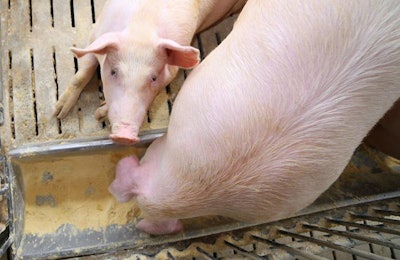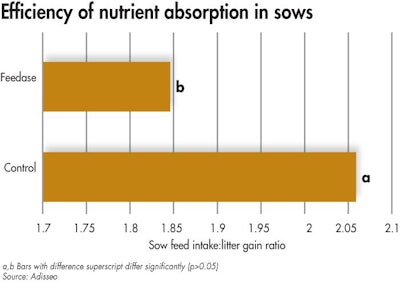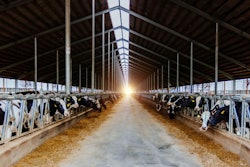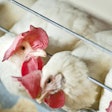
In order to ensure the future performance of sows and piglets, proper feed management and nutrition are key
Optimizing feed intake is one of the biggest challenges to managing the lactating sow. If feed intake isn’t sufficient to meet the nutritional needs of sows, the result is a negative energy balance. This will cause weight loss, subsequently affecting performance and longevity in the herd. Milk production will also be affected, negatively affecting piglet growth rate.
You are what you eat
Recent research has shown that litters reared by sows with higher feed intakes achieved significantly greater weaning weights, whether they had average or low birth weights. The effect of sow feed intake on litters of low-birthweight piglets were even more marked, with preweaning mortality reduced by nearly 50%. This effect continued for 10 weeks after birth – piglets that were heavier at weaning subsequently grew faster – indicating improved development.
There are many ways the sow’s environment will affect her feed intake, e.g., temperature, humidity, housing system. However, there are several dietary and feed management practices that can help optimize feed intake:
-
Raw materials
Sows are sensitive to the quality of and changes in feed ingredients used in their diets. This may cause transient or long-term reduction in feed intake. Where possible, the formulation of lactation diets should remain stable throughout the feeding period, to avoid potential reduction in feed intake or digestive upset. Palatability of raw materials should be considered, and quality monitored – including the presence of anti-nutritive effects factors.
Nutritional formulation, such as fiber or salt level, can also influence feed intake.
-
Mycotoxins
Pigs are particularly sensitive to mycotoxins and many are known to cause a depression in feed intake. Zearalenone in particular affects the reproductive system. Pregnant and lactating sows may be more at risk from mycotoxins than growing animals, particularly if the contaminated raw material is used at a high inclusion. Feed companies should be vigilant in their testing of raw materials and finished feeds.
Producers that home mix or use some of their own cereals should also seek advice on testing. However, mycotoxins can also form when the feed is being stored, so feed hygiene, storage conditions and regular cleaning are essential. The use of an in-feed mycotoxin deactivator is a useful tool, to support optimal feed intake and performance, against broad-spectrum mycotoxin contamination in feed.
-
Feed digestibility
With the aim of ensuring optimum nutrient availability for milk production, it is essential that sows get the most out of the amount of feed they are eating. Increasing feed digestibility can be achieved by raw material selection and the addition of enzymes. Several trials in sows have shown that the addition of a multi-enzymatic solution (a feedase) improved weaning weight of piglets, without any increase in sow feed intake. This demonstrates the ability of the products used to increase nutrient availability and hence milk production.

Sow body weight loss was also reduced in gilts and older sows. Efficiency was also significantly improved with a 10.3% improvement in sow feed intake:litter weight gain. Demonstrating that the 8.7% improvement in digestible energy content of the sow’s diet containing the enzyme, increased nutrient absorption; that was then transferred to milk and increased piglet weaning weights.
-
Water quality and quantity
Water is essential for life and, if thirsty, sows are unlikely to eat at an optimal level. Water consumption also has a direct effect on stool quality and, if animals are constipated, feed intake will be reduced.
-
Feed freshness – wet vs. dry
The use of wet feeding strategies can increase feed and water consumption. However, any deterioration of feed quality in these systems will have the opposite effect. With dry feed, presentation or dustiness, for example, may reduce palatability or even nutritional intake directly.
-
Monitoring during gestation and lactation
As the saying goes “you can’t change what you don’t know.” Whether ad libitum or meal feeding, it is vital for pig producers to know how much sows are eating. Then a judgement can be made whether there is an issue and how levels can be optimized. Gilts will eat less than second or third parity sows and older sows similarly; feeding management should be tailored accordingly.
Sow feed intake is restricted during gestation to avoid animals becoming overweight.
There is also a direct link between the amount of feed a sow eats during gestation and how much she will consume during lactation – restriction during gestation has been shown to increase intake in lactation. Feed restriction in gestation needs to avoid hunger and negative effects on metabolism, while not compromising the animal’s potential to eat for milk production during lactation.
-
Amount offered and timing
Studies have shown that sows eat most of their daily intake in the morning and evening, with less eaten in the middle of the day. The latter effect is exacerbated in hot climates, as this is the period when heat stress is most likely to occur. Feeding management should ensure that sufficient fresh feed is available for the sow to eat at the beginning and the end of the day.
-
Palatability enhancers
In-feed palatability enhancers have been used with success to improve feed intake in sows. A trial carried out in a hot climate showed that feed intake increased from 5.08 kilograms per day to 6.02 and 6.60, when a palatability enhancer was added at 250 or 500 grams per ton, respectively.

Feeding behavior also changed, with sows eating more at each meal. The performance of the sow and her piglets were monitored, with a calculated increase in milk production of 11% and 51% respectively. As a consequence, weaning weight of the piglets was significantly increased.
What’s best for the sow is also best for the piglets
Feed intake isn’t just about the current lactation period; it is important for future herd productivity that the sow enters her next cycle in optimum condition. With gilts, not only is optimum nutrition required for supporting milk production, but her continued growth and development as an immature female. Any undue nutritional stress on sows during lactation, particularly in gilts, will affect her health and longevity.
For piglets, getting it right at the start sets them up for a successful life. An adequate supply of high-quality colostrum and milk are producers’ key aims, to ensure optimum weaning weight and continued growth efficiency. To achieve this: nutrition, intake and feed management of the sow need careful monitoring and control.
References available upon request.















